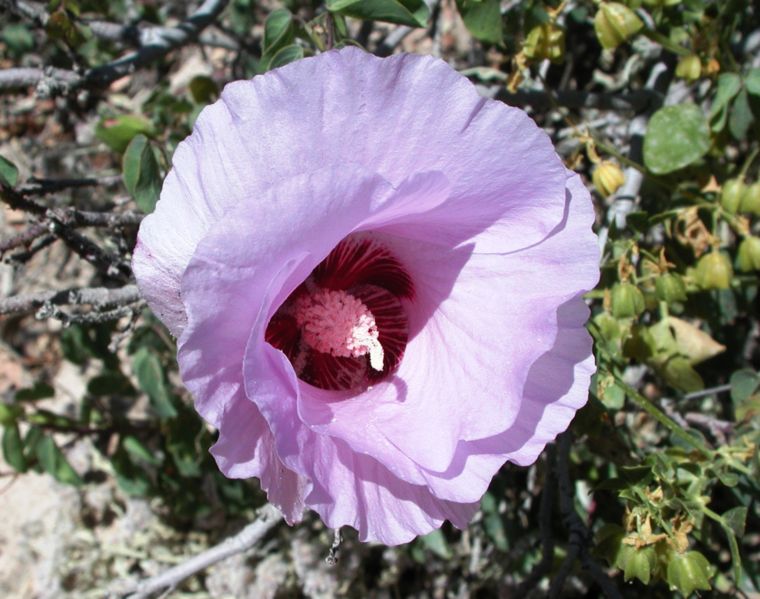- Gossypium sturtianum
taxobox
name = Sturt's Desert Rose
status = R
status_system = QLDNCA
regnum =Plantae
unranked_divisio =Angiosperms
unranked_classis =Eudicots
unranked_ordo =Rosids
ordo =Malvales
familia =Malvaceae
genus = "Gossypium "
species = "G. sturtianum"
binomial = "Gossypium sturtianum"
binomial_authority = J.H. Willis|Sturt's Desert Rose ("Gossypium sturtianum") is a woody
shrub , closely related to cultivatedcotton , found in all mainland states ofAustralia and theNorthern Territory . It has a life cycle of about 10 years, grows from 1-2 m tall and 1-2 m wide.The
colour of the petals can range frompale pink to darkpurple to maroon. The five petals are arranged in a whorl and have a dark red centre. There is a small cotton spore in the centre of the flower. They can be seen for most of the year but peak in latewinter . They are up to 12 cm in diameter. The leaves are different shades of green, round and stronglyscent ed when crushed.There are two variations of the Sturt's Desert Rose. Variation "nandewarense" is found only in north-eastern
New South Wales (aroundNarrabri ) and theExpedition Range in centralQueensland . The more common variation, "sturtianum", is found everywhere else.The Sturt's Desert Rose is found in
sand y andgravel ly soils, along dry creek beds,watercourse s,gorges and rockyslopes . This means that it must be able to store and conserve water. Adaptations for this plant include:* A strong internal structure. This prevents wilting and reduces transpiration (sweat).
* There are fewer stomata (the pores that release gas in the leaves) or they are protected. The stomata on the Sturt's Desert Rose are found on the underside of the leaf. This means reduced water loss.
* They have internal water storage. This reduces the need to rely on rain to stay watered. These sources could be in the trunk, root system or leaves.
* Deep root systems. They are able to reach the water deep under the ground.
* The seeds of the plant do not function before they are germinated. This means they have more chance of surviving.
* Sturt's Desert Rose contains the substancegossypol . Gossypol is toxic to all non-ruminant (cud-chewing) animals. This means the shrub has less chance of being eaten.The Sturt's Desert Rose was discovered by
Charles Sturt in 1844-45. In 1947, JH Willis gave the shrub its current botanical name. It is not considered to be at risk in the wild.The Sturt's Desert Rose is the floral emblem of theNorthern Territory and appears in stylised form on the official flag. It is also known as the Darling River Rose, Cotton Rosebush and Australian Cotton.External links
* [http://www.anbg.gov.au/emblems/nt.emblem.html Sturt's Desert Rose - Floral Emblem of the Northern Territory]
Wikimedia Foundation. 2010.
